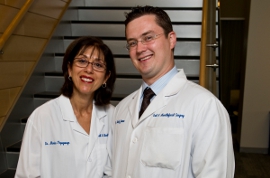Exchange with India
By Gail Bambrick
Tufts residents gain a world view of dental practice

Department chair Maria Papageorge and oral surgery resident Marty Jarmoc. Photo: Alonso Nichols
The first thing a visitor notices in the hospital waiting room in Dharwad, India, are the rows of children sitting and waiting their turn for treatment. They all were born with cleft lip and palate. “Many have come a long way from remote rural areas for this chance at a normal life,” says Marcin (Marty) Jarmoc, an oral and maxillofacial surgery resident who recently returned from an exchange program Tufts offers in collaboration with the S.D.M. College of Dental Sciences & Hospital.
“It is a beautiful and modern facility,” Jarmoc says of the hospital. And it has a daunting mission: it is the only institution in India that provides care for patients with cleft lip and palate as well as large tumors and temporomandibular joint (TMJ) disorders.
Between 1,000 and 1,200 patients are treated every year in the hospital’s 50-bed craniofacial unit, says Chava Bhasker Rao, the founding dean and current director of the S.D.M College of Dental Sciences & Hospital. Established in 1986, the institution’s 40-acre campus sits along National Highway 4, the main thoroughfare between Bangalore and Pune.
The pace of the work and the advanced stages to which patients’ diseases have progressed—the result of lack of money or access to care—are issues a dental resident would not experience in the U.S., Jarmoc says. The Tufts residents see cases such as ankylosis, a condition in which the temporomandibular joints fuse shut and people are unable to open their mouths, as well as cancers not common in the U.S.
And there are other differences—like the window in the operating room, Jarmoc says. “Because the power goes out as often as once an hour, it assures there is always light in the surgery while the back-up generator is kicking in,” he says.
Many of the cleft palate surgeries are paid for by Smile Train, an international charity that funds such operations for children in 78 countries around the world. Without outside help, other families have to come up with the money for the surgery on their own, which means many with a range of conditions go untreated until they can find the funds, Jarmoc says.
And because it is an exchange program, oral and maxillofacial surgery residents from India also come to Tufts, where, Rao says, it is the interdisciplinary scholarship and research that helps them the most.
“The interdisciplinary lecture classes were extremely well received by our residents, as were the Tumor Board Meetings, where multidisciplinary solutions to tumor management were evolved,” Rao says. “Another major benefit was the inter-school collaborative research projects,” he says, including studies on otoplasty techniques for rebuilding the ear.
The idea for the exchange program was first discussed in 2005, when Noshir Mehta, DG73, DI77, director of Tufts’ Craniofacial Pain Center, and Dean Lonnie H. Norris, DG80, visited the S.D.M. College of Dental Sciences.
“The program is now four years old, and we have been involving several students from both institutions each year,” says Maria Papageorge, D82, DG86, DG89, professor and chair of oral and maxillofacial surgery, who coordinates the Tufts side of the exchange.
In addition, Tufts and S.D.M. College have also signed an agreement to expand research collaborations, and faculty from both institutions are working together to develop joint research ventures.
